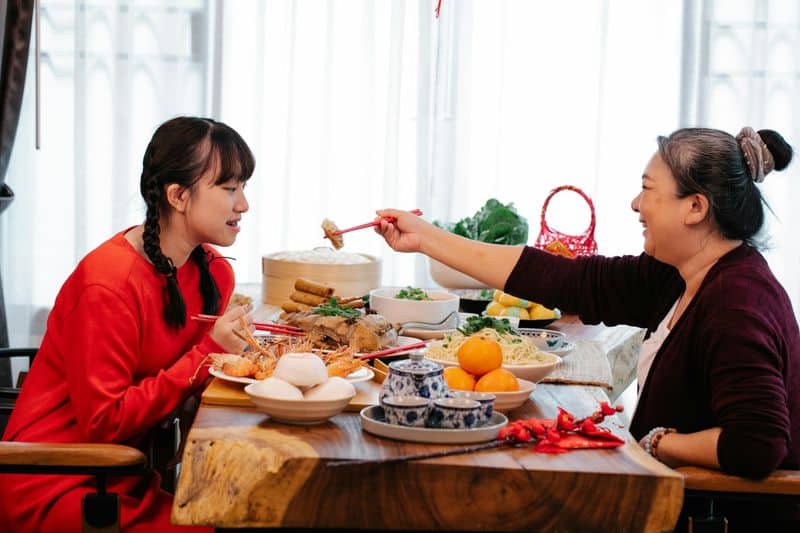The 1960s were a time of formality and strict manners, especially at the dinner table.
Families adhered to a set of rules that might seem outdated today, but once dictated how every meal was conducted.
These rules not only instilled discipline but also promoted respect and family bonding.
In this exploration of dining etiquette from the past, we delve into 10 specific rules that were non-negotiable and reflect on how times have changed.
1. No TV or Media During Dinner

Back in the 60s, family dinners meant undivided attention. Any form of media, including TV, was strictly off-limits during mealtime.
This rule ensured that conversations flowed naturally, strengthening bonds between family members.
The focus was entirely on communication and shared experiences, allowing everyone to catch up on the day’s events.
Such rules seem almost unimaginable today, where multitasking during meals is the norm. Imagine a dinner where every device is out of the picture!
2. Finish Your Food

Leaving food on your plate was simply not acceptable in the 60s. Children were taught from a young age to appreciate the meal prepared for them.
Finishing all the food was a sign of gratitude and respect for the effort put into cooking. Wasting food was frowned upon, reflecting a cultural emphasis on valuing resources.
This expectation was part of teaching responsibility and awareness. Today, encouraging kids to eat mindfully without waste remains a worthy goal.
3. Elbows Off the Table

Minding one’s manners was paramount, and keeping elbows off the table was a key rule.
This practice taught children to sit up straight, enhancing posture and attention during meals.
Such etiquette also reduced the risk of accidental spills, maintaining cleanliness at the table. By practicing discipline in dining, families emphasized respect for shared spaces.
The importance placed on such manners continues to influence dining etiquette today, promoting an awareness of physical presence.
4. Ask to Be Excused Once Done

In the 60s, children were expected to ask for permission before leaving the table, instilling respect and formality.
This practice reinforced the concept of communal dining as a shared experience.
By waiting for acknowledgment, children learned patience and consideration for others. It also offered parents an opportunity to engage with them about their day.
Such practices fostered a sense of belonging and importance within the family unit, values that remain significant today.
5. Set the Table Before the Meal

Setting the table was not just a chore, but a lesson in responsibility and coordination.
Children were often tasked with this duty, learning the proper placement of utensils and tableware.
This rule taught planning and precision, skills transferrable to other areas of life.
By engaging in this practice, families prepared meals together, enhancing anticipation for the shared experience ahead.
Today, the tradition of setting the table can still be a delightful prelude to dining.
6. No Phone Calls During Dinner

Though smartphones were not around in the 60s, phone calls were equally interruptive.
Answering a call during dinner was discouraged to maintain the sanctity of family time.
This rule emphasized the importance of being present and engaged during meals. Such discipline highlighted that family interactions took precedence over external communications.
By prioritizing face-to-face conversations, families cultivated deeper connections, a practice still cherished in today’s fast-paced world.
7. Wait Until Everyone Is Served to Eat

Patience was a virtue practiced at the dinner table, where etiquette dictated waiting until everyone was served to begin eating.
This rule reinforced equality and consideration at mealtime.
Such manners taught respect for the meal and those who prepared it. It also encouraged synchronous dining, allowing shared enjoyment of the food.
The lesson of waiting for others remains a relevant reminder of courtesy, fostering mindful eating in group settings.
8. Proper Napkin Use

Napkin etiquette was stressed, with children taught to place their napkins neatly on their laps. This practice minimized mess and encouraged cleanliness during meals.
Proper napkin use was part of a broader lesson in dining decorum, reinforcing attention to detail.
Families prioritized such habits to instill lifelong skills of graciousness and poise.
The mindfulness inspired by this rule helps cultivate a respectful and tidy dining environment, even in modern times.
9. No Reaching Across the Table

Reaching across the table was discouraged to maintain order and politeness.
This rule was about respecting personal space and preventing accidents like spills or knocked-over items.
Requesting items to be passed encouraged communication and interaction at the table.
Such etiquette fostered a strong sense of consideration and patience, core values in family dining etiquette.
These lessons in mindful behavior contribute to harmonious meals, even amidst today’s relaxed dining atmosphere.
10. Children Eat Quietly

Children were expected to eat quietly, minimizing disruptions during mealtime. This rule trained them in self-control and respect for the dining experience.
Quiet dining allowed for a peaceful atmosphere where conversations could thrive without interruptions.
It also taught children the importance of listening and absorbing the environment around them.
Encouraging quietude at the table remains a valuable practice, promoting focus and harmony during meals.

